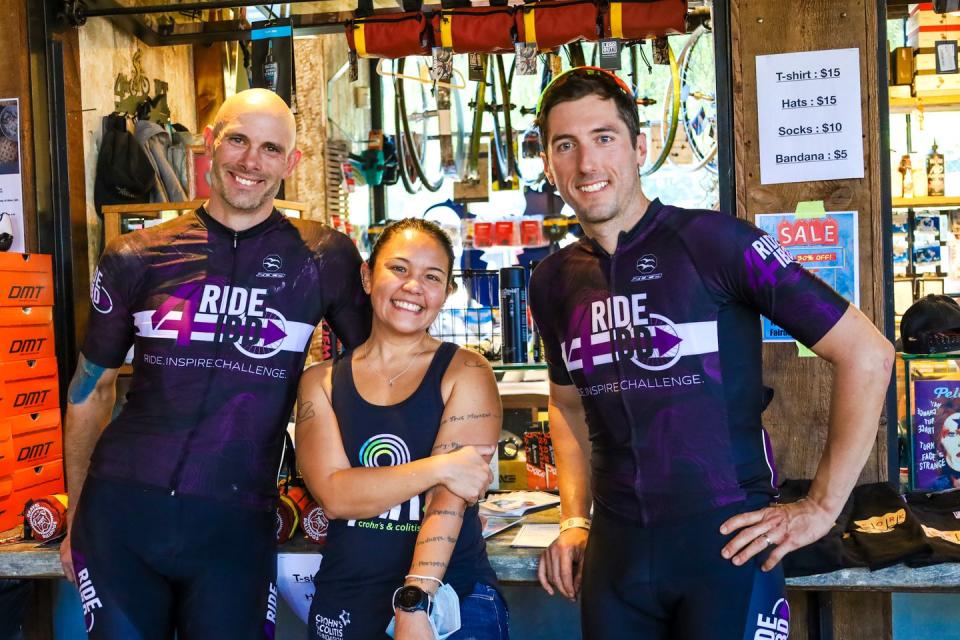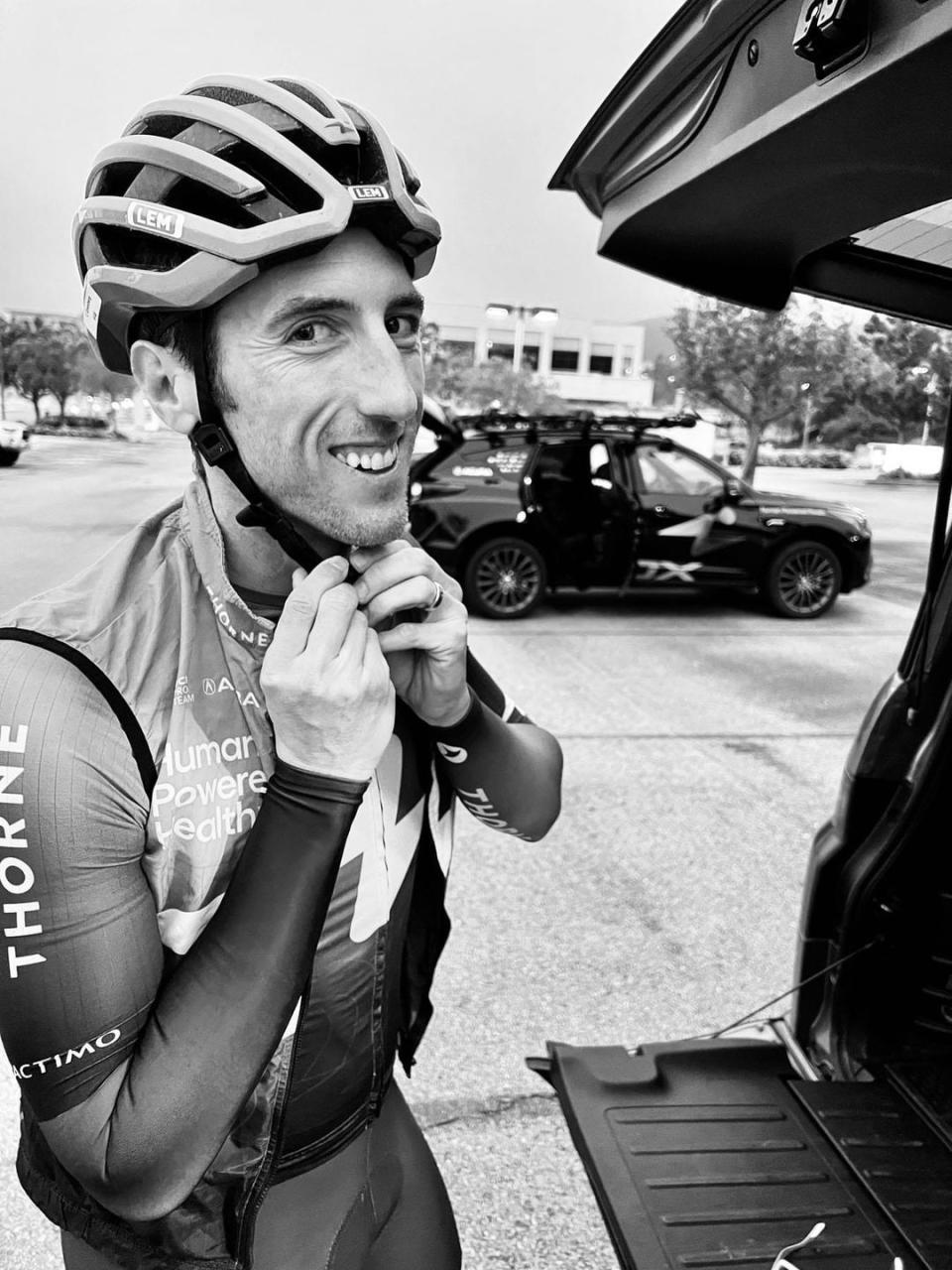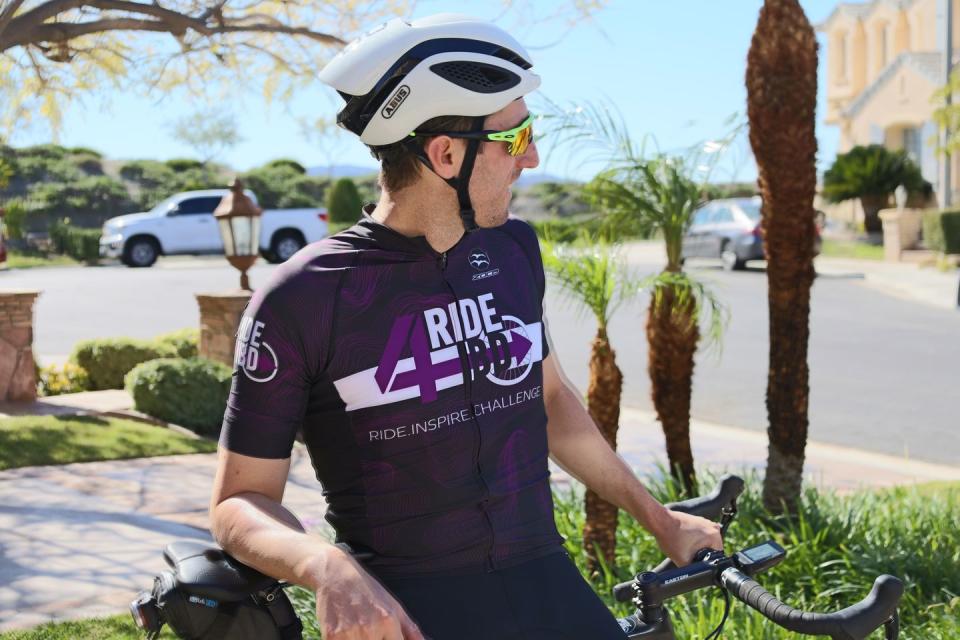How One Professional Cyclist Isn’t Letting Inflammatory Bowel Disease Stop Him From Racing

Battling chronic illness has its own challenges. And when you’re a pro cyclist, who relies on his body to consistently push pedals and score podium finishes, taking on an illness like inflammatory bowel disease—a chronic condition characterized by inflammation in the digestive tract and symptoms like fatigue, diarrhea, and weight loss—handling those challenges takes on a whole new meaning.
Cyclist Cory Greenberg, who went pro and joined team Human Powered Health in 2022, knows this well. He has come a long way from where he was more than a decade ago, when the Simi Valley, California-based rider was sleeping next to a toilet with violent stomach cramps and the uncontrollable urge to go to the bathroom. “I was at a training camp, and I couldn’t get off the toilet,” he says. “I had no energy—I felt weak, and that kept progressing until I was unable to function anymore.”
Today, Greenberg has a different story, but a long, winding road led him here.

Getting an IBD Diagnosis
Now 35 years old, at the age of 21, Greenberg was diagnosed with ulcerative colitis, one of the two main types of inflammatory bowel disease (IBD), marked by inflammation in the large intestine. (This condition is much different than irritable bowel syndrome, though the two are commonly confused.)
In addition to ulcerative colitis, IBD can also show up as Crohn’s diseases, but they’re both chronic immune-mediated conditions, says David T. Rubin, M.D., professor of medicine and chief of the Section of Gastroenterology, Hepatology, and Nutrition at the University of Chicago Medicine, and chair of the National Scientific Advisory Committee for the Crohn’s & Colitis Foundation. That means the immune cells play a role.
“IBD means that the immune system of the gut, which is there to protect us, is overactive, or dysregulated, meaning it doesn’t have control,” Rubin says. The chronic inflammation of the intestines from IBD can cause symptoms like irregular bowels, or more frequent stools, sometimes accompanied by urgency, leaking, or inability to empty the bowels, blood in the stool (which can result in anemia), and bloating.
It was prior to a mountain bike race in Big Bear, California when Greenberg used the restroom and noticed blood in his stool. When Greenberg told his parents, he found he had a family history of IBD: his grandmother’s mother died from Crohn’s Disease, the other main type of IBD.
His grandmother pushed him to see a doctor, and while he did go, he was initially misdiagnosed with a hemorrhoid. As the problem persisted, Greenberg eventually saw a gastroenterologist, who revealed the ulcerative colitis diagnosis.

A More Vocal Approach to Disease Management
Because of the embarrassing nature of the disease, Greenberg says he was initially secretive about his symptoms and suffering. “That’s not necessarily the best way to approach a chronic illness,” he admits.
While Greenberg wasn’t feeling 100 percent for a few months of 2009 after his diagnosis, mainly due to blood loss and lack of energy, the following season he was riding well and feeling physically normal again. But he still didn’t let anyone know he had IBD. “I had to use enemas and suppositories to treat the condition, which was so embarrassing, especially having to hide it from my teammates at camps or on the road,” he says.
For about a year and half, the cyclist rode well, but then things got worse again, which is when Greenberg found himself unable to leave the bathroom at training camp.
“It got to a point where I was just incapacitated,” Greenberg says. “You can just all of a sudden overnight go from being completely healthy and doing so well on the bike and being an up and coming U23 rider [a men’s under-23 cyclist] and then suddenly you’re sleeping on a bathroom floor and unable to function.”
As his disease progressed, Greenberg was faced with either having his entire colon removed or starting intensive medication. He chose the latter. “My whole existence was cycling and all I knew was how to prepare for a bike race and how to see the world through the lens of an athlete,” he says. “I wanted to be a professional cyclist. I didn’t want to lose my colon and have a [colostomy] bag for the rest of my life…that was a moment in time where I used my mindset as an athlete and used it to approach this condition.”
“When I prepare for a bike race I look at my diet, I work with a coach, we have mechanics that work on our bikes, we have nutrition strategies, we see a chiropractor, we do all these different things to prepare to be at our best,” Greenberg adds. “I said, I’m gonna take that mindset and treat my condition this way.”
Not only did taking control of his IBD mean finding medications that work, but also leaning into his circle, including his doctors, friends, and family. “Honestly, being outspoken about what [I was] going through, that opened a huge door,” he says. Speaking freely about his symptoms, medication, and overall battle with IBD allowed Greenberg to feel like himself and like IBD wasn’t controlling his life.
As for maintaining his health, Greenberg has also learned the importance of putting himself first. “I’m not saying be selfish, but it’s okay to take a step back and be like ‘no I need a moment,’ because if I don’t take a moment for myself right now, or if I don’t reach out to people it’s only going to make [this condition] worse,” he says.
How Greenberg Manages IBD
Greenberg’s IBD has been in remission for 10 years now. “That means I’m in a maintenance phase,” he says, which he equates to building fitness. “We build our bodies up and then we kind of maintain this level of fitness and it’s the same with this condition.”
To maintain his health, Greenberg takes a once monthly injectable medication that helps support his immune system, works to curtail flare ups, and also repair his large intestine.
Rubin says the general goal for patients with IBD is to reach deep remission, meaning you’re not only feeling well, but the bowel is no longer inflamed. “We have a variety of very safe, targeted therapies for the intestines and even some newer strategies incorporating dietary adjustments on top of the medical therapies that can get a patient into remission,” he says.
To stay on top of his gut health Greenberg also takes the Throne Gut Health Test every six months. “What it will show is the state of your gut bacteria, both good and bad, and how to optimize the gut in terms of promoting and supporting the good bacteria and reducing the bad,” he says.
Part of maintaining good gut bacteria means finding a diet that works for Greenberg, which he says has taken some trial and error to find the foods that keep him feeling his best. “The issues that a lot of us face living with this condition is that there are things that exacerbate it, and dairy and gluten are ones that really have an impact on my life,” he says.
While limiting these foods works for Greenberg, Rubin cautions that gluten- and dairy-free diets are not a substitute for proper medication to eliminate inflammation of the bowels. Doctors are also still investigating the role diet plays in conditions like IBD.

Cycling for IBD Awareness
Greenberg, inspired to keep others with IBD cycling, started a ride—dubbed The Ride for IBD, with the motto “ride, inspire, challenge”—to raise money for the Crohn’s & Colitis Foundation. “The Ride for IBD stems from my personal journey, from the beginning of my time living with IBD, and to this point now in the experiences that I went through as a patient and as an athlete,” he says. “We ride to inspire others to challenge their condition.”
The first event, in 2019, took place virtually on Zwift. But in 2021 and 2022, riders took to the roads of Calabasas, California and transversed some 50 miles. The next ride is planned for the fall 2023.
“I’m pushing the limits of maybe what’s possible with professional sport and IBD to show people that you can live with this condition and challenge it at the highest level,” Greenberg says.
Greenberg believes using the bike to promote a health and wellness movement is a great platform for him. He aims to break down social stigmas related to his condition, while building up IBD patients to live a normal, healthy life. “The idea of helping other IBD patients realize that they, too, can challenge their ideas of what IBD looks like, and ride past the diagnoses, along with showing the world what IBD is—it means the world to be alongside fellow IBD patients and to be making IBD visible,” he says.
In addition to The Ride for IBD, Greenberg continues to ride professionally. “For me, the motivation is to be able to show up at any race and be ready, and prove myself amongst the peloton,” he says.
Tips for Cyclists Battling IBD, According to Greenberg and Rubin
Be open about your health
Greenberg encourages athletes to take a step back and recognize they may need support. “One in 100 people deal with [IBD] in the United States, and we all deal with, from time to time, gut-related problems, so being able to be outspoken about it is key,” he says.
Greenberg offers the example of ordering the food that works best for you when out for a group dinner, but speaking up for yourself could also mean telling others when you need a day at home for rest or that you need bathroom breaks along your bike route. “Just being a little bit more self focused [is helpful] so that you’re treating this in the best way possible, because at the end of the day, you’re the one who has to live with it,” he says.
Utilize technology
Greenberg uses his smartwatch and phone to help determine his levels of fatigue and stress. More specifically, he turns to the HRV4Training app for insights into his heart rate and heart rate variability. This allows him to tailor his training based on the data he’s receiving.
The HRV4Training app can provide a systematic analysis of day-to-day changes in your heart rate variability following training, alcohol intake, travel, menstruation, and sick days. Noting these changes in heart rate variability and resting heart rate can then help you decide when to push it in your workouts or when some low-intensity exercise or a rest day is in order. This is similar to devices like the Oura ring and Whoop watch, which take heart rate variability into account to offer a workout readiness score.
Enjoy your life
Greenberg advises those with IBD to treat it as part of your everyday routine, accepting the struggles, and focusing on the future. “Sometimes it’s through these challenges that we get a better approach to moving forward,” Greenberg says.
The Pro Road National Championships in Knoxville, Tennessee this past June was a learning experience on enjoying life more for Greenberg. While he felt physically conditioned for the race, mentally he says he wasn’t prepared.
“I took an approach where I narrowed in on the goal so much that the mental side of it became overwhelming and that completely destroyed my performance on the day because I over focused [on the training] and under prepared mentally for the stress,” he says. “I stopped going and seeing friends, and going out to dinner. Everything was eat, sleep, ride.” Greenberg acknowledges he missed the component of relaxing during his training and setting boundaries for his riding.
Exercise With Caution
IBD patients should be aware of the state of their disease before exercising. One thing Rubin notes for those with IBD is that exercise during a flare-up can be taxing on your body. “You don’t want to be putting your body to the limit when you’re inflamed or when you might be anemic—these are things that will limit your exercise endurance or tolerance,” Rubin says. He also encourages patients to confirm that their labs are appropriate for exercise and to discuss with their health care team if they truly are in remission.
If you are exercising, Rubin advises to pull back when you start to fatigue easily or find that you have shortness of breath. He also suggests checking in with your doctors before starting an exercise regimen, and confirming that you’re not anemic or actively inflamed.
Also, make sure to practice good sleep hygiene—meaning following a routine sleep-and-wake cycle, which may help tame inflammation.
Pay Attention to Heart Health
Rubin says there is emerging evidence that chronic inflammatory conditions, including IBD, are associated with cardiovascular risks. “It’s thought to be that the general systemic inflammation of a chronic inflammatory condition can actually increase the likelihood of coronary artery disease. So it’s important for people to know—especially when you’re getting a little bit older, if you’ve lived with IBD, how your heart health is,” Rubin says.
You Might Also Like

